Climate skeptics have new favorite graph; it shows the opposite of what they claim
Posted on 26 March 2025 by Zeke Hausfather
This is a re-post from the Climate Brink
Last September the Washington Post published an article about a new paper in Science by Emily Judd and colleagues. The WaPo article was detailed and nuanced, but led with the figure below, adapted from the paper:
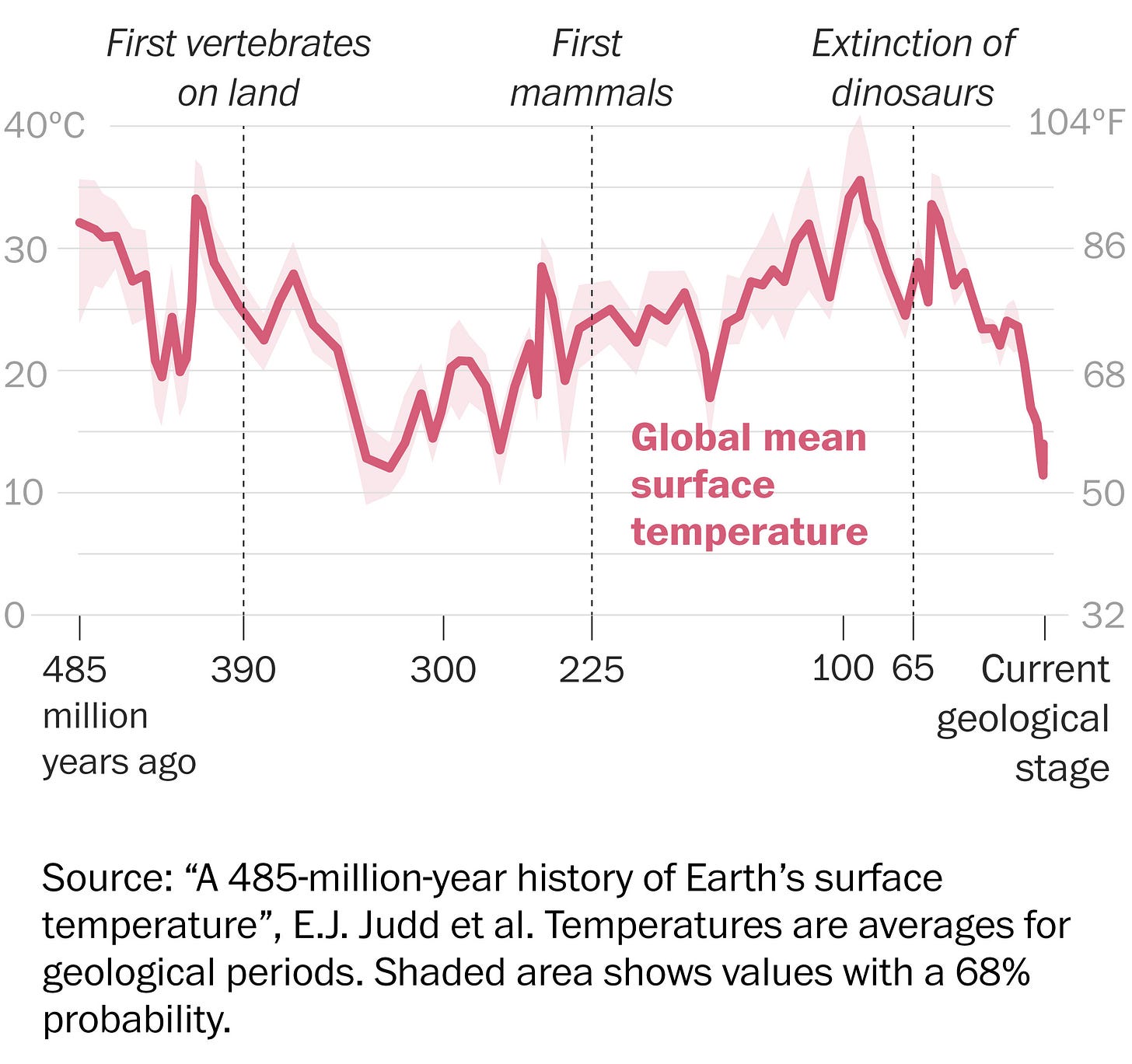
The internet, being less prone to detail and nuance, ran with the figure, with climate skeptics calling it their “new favorite graph” and reposting it everywhere, claiming that it shows the insignificance of recent human warming relative to the Earth’s long temperature history.
The furor over the graph reached its apogee in January when Joe Rogan showed it in a podcast interview with Mel Gibson, saying that “If you believe these silly people, way before human beings had ever existed, there's always this rise and fall. And this idea that the whole thing is based on carbon emissions from human beings is total bullshit. It's not true. Right. We might be having an effect, but we're having a small effect, a very small effect.”
The actual paper says otherwise
So we decided we’d do the barest amount of actual diligence on the claim. We read the actual paper (non-paywalled version here). And, lo and behold, we found that rather than dismissing the role of CO2 on longer-term changes in the Earth’s climate, it makes one of the strongest claims yet that “CO2 is the dominant driver of Phanerozoic climate [the past 485 million years], emphasizing the importance of this greenhouse gas in shaping Earth history.” The authors even express surprise that CO2 explains so much of the apparent temperature variation, and that solar variability does not have as dominant an effect.
It turns out that the Washington Post’s graphic only shows half the picture. Here is Figure 4 of the Judd et al 2024 paper, showing both temperature (the plot the WaPo recreated) and CO2 over the past 485 million years. For most of the record the two changed in lock-step, with hotter periods almost invariably having higher CO2 concentrations and cooler periods having lower CO2 concentrations (note that CO2 serves as both a forcing – e.g. during periods of excess volcanism – and a feedback to other external forcings during the Earth’s past).
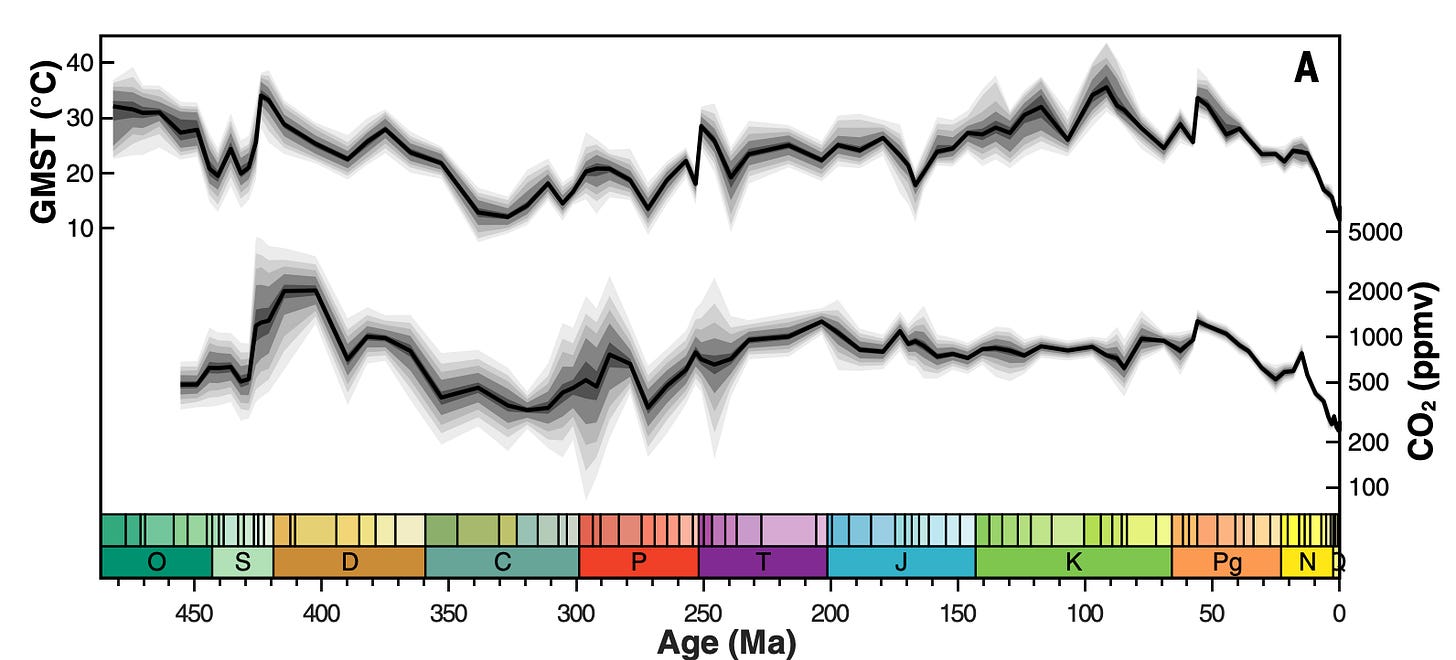
We also thought to ask the actual authors of the paper what they thought about how their work was being (mis)used in various corners of the internet.
Lead author Dr. Emily Judd replied (emphasis hers):
I’ve seen quite a bit of misinformation crop up surrounding our paper – particularly the claim that we (humans) have nothing to worry about, with respect to climate change, since the Earth has been warmer for much of the last half-billion years. I cannot stress enough how reductive and problematic this viewpoint is. The flaw in this logic boils down to two key points:
(1) the resilience of the planet does not directly translate our own species’ ability to adapt and thrive in the face of human-caused climate change, and
(2) the impact of anthropogenic climate change is (and will continue to be) determined by the rate of change (meaning how quickly CO2 and temperature change) much more than the absolute temperatures, themselves.…When we compare CO2 and temperature across the last half-billion years, we find a strong correlation between the two parameters, which indicates that CO2 has exerted a strong influence on global temperature not just today and in the recent past, but across the last 485 million years of Earth’s history.
Similarly, author Dr. Jessica Tierney told us:
Joe [Rogan] seems to be saying that because – geologically speaking – we are in a colder climate that we don’t have to worry about human-caused global warming. Nothing could be further from the truth. It certainly has been warmer that today in the deep geological past, but those past warm periods developed slowly over millions of years. As a consequence, life on Earth had time to adapt. The problem with current global warming is the speed. The warming that humans are causing is unbelievably fast, and so humans and the other forms of life that we share the planet with can’t fully adapt. In fact, rapid warmings in the geological past are often associated with mass extinctions – abrupt climate change is hard for life to tolerate. So that underlies the danger in allowing our climate to warm so fast right now.
What our study actually shows is that CO2 is the dominant control on Earth’s temperatures across geological timescales. Every time CO2 is high, temperatures are warm. So it follows naturally that, as humans emit more CO2, the climate warms. The study reinforces the strong connection between CO2 and climate change.
It’s not just how hot, but how fast
While Earth has experienced warmer periods in its deep past, the seriousness of climate change is defined by its pace. The warm temperatures in Earth’s past unfolded over millions of years, giving life ample time to evolve. In contrast, today's changes are happening at an unprecedented rate—within decades rather than millennia—leaving inadequate time for adaptation.
The geological record offers sobering evidence of what happens when climate change occurs too rapidly: mass extinctions.

The above figure plots surface temperature (black) for the past 485 million years along with mass extinction events (orange vertical lines). The timing of two events are coincident with rapid climate fluctuations:
-
The Late Ordovician mass extinction (440 million years ago) saw approximately 60% of marine species vanish.
-
The Permian-Triassic extinction (251 million years ago), often called "The Great Dying," eliminated 90% of all species during a period of dramatic climate change linked to volcanic CO? emissions.
This record demonstrates that climate change can have extreme consequences. Organisms don’t have time to adapt and risk extinction.
As Dr. Judd told us:
The geologic record has taught us that when CO2 and temperatures change slowly, organisms can keep pace with the environmental change – evolving, developing adaptations and/or migrating to new places. However, when CO2 and temperatures change rapidly, as is happening today due to anthropogenic emissions, evolution can’t keep pace with the environmental change. We’ve seen this before at the end of the Permian, due to widespread volcanism, and at the end of the Cretaceous, due to an asteroid impact – when the climate and the environment change rapidly, evolution simply can’t keep up.
What is happening today is particularly catastrophic because the organisms that exist evolved to tolerate the icy conditions of our modern planet – just like humans, they’re cold adapted. They (and we) are not equipped handle the warmer conditions and the rate of change is too fast for evolution to keep pace. Not only have humans evolved to tolerate colder conditions, we have also established our populations close to water sources and often near sea level. As we observe the Earth warming at a rapid pace within human time scales, we are faced with challenges such as more intense storms, more frequent and intense droughts (in some regions) and floods (in some regions), rising sea levels, and, ultimately, a reduction in habitable and arable land.
Carbon dioxide controls the climate
Another key insight from this record is the consistent relationship between atmospheric carbon dioxide levels and global temperatures across the geologic record. Throughout Earth's history, this correlation is remarkably clear: when CO? concentrations rise, temperatures follow.
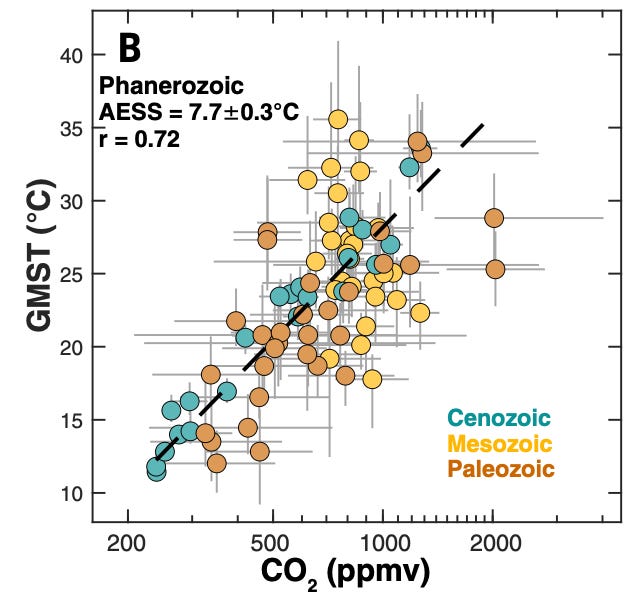
Humans have increased atmospheric CO? by approximately 50% in just 150 years—a mere instant on the geologic timeline. Predictably, temperatures have responded, with 2024 measuring 1.55°C warmer than pre-industrial levels.
So yes, Earth has been hotter, but the pace of climate change is more important than absolute temperature. Organisms today (humans included) have evolved in colder temperatures, and the geologic record shows us that rapid warming could devastate our cold-adapted ecosystems.
Note: This article is a collaboration between Zeke Hausfather and Devin Rand, a research scientist at Berkeley Earth.































 Arguments
Arguments




























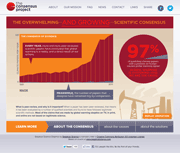
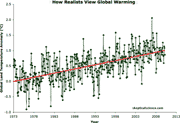
Great article!
The analogy I like to use to explain why the rate of warming is important is Speed Kills.
When exiting a freeway, you slow down from 60 mph (100 kmh) to rest in about 30 sec. This is a nice, reasonable rate of change. What happens if you speed up that rate of change by a factor of 100?
[BL] Link fixed...
I knew which graph just from the title after I commented on the original Washpost article here: www.washingtonpost.com/climate-environment/2024/09/19/earth-temperature-global-warming-planet/?commentID=3e500d42-0006-4924-a353-36bd06f848fb I won't repeat all my critiques, but here's the most important one: the paper doesn't support the claim of unprecedented warming. That was invented by the Post authors. That's particularly obvious after reading the supplemental: www.science.org/doi/suppl/10.1126/science.adk3705/suppl_file/science.adk3705_sm.pdf The data points for rapid transitions are much too sparse to compare to a century or so of manmade warming.
Eric@2, whether the label "unprecedented warming" is or is not warranted is kind of like debating whether the Category 5 Hurricane that just wiped out your town was or was not a hurricane of unprecedented strength. The current warming of 0.2C/decade (read here) is likely incompatible with organized human civilization and the well being of Earth's rich biodiversity. Let's not spend too much time debating terms and instead figure out what to do to slow down the rate of warming.
I agree with Eric that we dont have enough data points hundreds of millions of years ago to know if there was a single century or two of warming of several degrees. However the current rate of warming is unprecedented in the last 2,000 years and probably the last 10,000 years. We have enough fine grain detail and data points to know this and numerous studies on it. And its the stability of this period that human civilisation developed within. Billions people and their agiculture and infrastructure are most likely very reliant on this relative stability.
This is all being put at risk by politicians and other people that deny the climate problem and place their personal and unlimited wealth accumulation and tax cuts for millionaires and already profitable corporations above literally all other considerations. If this isn't an addiction, then what is?
Nigelj@4, I'm sure you're aware that using ice-core data, we have sufficient data going back more than a million years to say that the current warming is unprecedented back that far.
The reason that is important is that coming out of ice-age cycles (i.e., during deglaciation), warming occurs at a rate to which most of the biosphere can adapt. With the current warming occurring about 100 times faster than that deglaciation rate, many species will not be able to adapt fast enough. The faster we change temperature, the more stress it puts on the biosphere.
Nigelj@4, we love to rail at politicians, but remember that in countries with freely-elected leaders, we elect these people. The root of the problem still lies with us and the choices we make.
"The root of the problem still lies with us and the choices we make." and there's the crux of the issue- You would surely think where are the mass protests against this guaranteed existential threat from a too rapidly ever warming planet? The increasing instability to our food and water systems- the insurance/financial- political- pandemics and on and on. The flora and fauna are victims as too the human pollutors.
People dont want to lose their choices- the cars we drive, with the increasing "features"-the ailes in supermarkets for toothpastes or pet food or breakfast cereal-the endless fashion loop of clothing-the overwhelming desire for your children to become adults with a good job and a comfortable lifestyle and on and on. I cannot remember where I copied this next quote from but it describes some of my thoughts..
"Capitalism is not about a natural supply and demand. Capitalism is about MANUFACTURED demand, for which those who manufacture such demand, also "happen" to have a supply. There is little demand for weapons until the capitalists manufacture an international conflict. Most individuals don't need the vast majority of things they are told they should buy, so capitalists manufacture an insecurity in them so they feel inadequate without these trinkets.Bingo. And that "manufactured demand" is not only putting us in danger of serious military conflict, it's also RUINING the planet because we arent managing finite resources smartly.
I am not surprised that the paper’s presentation of 485 million years of temperature history was irrationally misinterpreted. Some people desperately seek any excuse to maintain their harmfully incorrect beliefs about climate science, and many other matters. They can be especially desperate to prolong or increase the benefits they can get from delaying the ‘responsible, ethical and moral’ corrections of harmful developed human beliefs and behaviour that climate science has identified.
The fact that human civilization has only existed in the last 10,000 years (less than 0.002% of the length of the chart) has to be ignored by some people to maintain their desired misunderstandings.
It took me less than a minute to find the following Phys.org report from 2021: Global temperatures over last 24,000 years show today's warming 'unprecedented'. It presents details of the temperatures in that tiny right-hand end of the misunderstood chart from the 485-million-year paper. (Note that the title includes a term that some people attempt to claim does not apply to the results of modern-day human impacts on the planet).
Undeniably, many people are easily tempted to believe misunderstandings about research results like this report. And, unfortunately, some people are so passionately emotionally invested in their misunderstandings that they powerfully resist attempts to get them to care to learn that their beliefs are ‘harmfully incorrect’.
Harmfully misleading pursuers of popularity and profit like Joe Rogan (and like Musk, and Trump, and all the people who bought memberships in Trump’s Mar-a-Lago Cult) are unlikely to be influenced by efforts to get them to learn that their preferred beliefs are harmful incorrect. They will behave like the following quote from this re-posted Climate Brink story.
The furor over the graph reached its apogee in January when Joe Rogan showed it in a podcast interview with Mel Gibson, saying that “If you believe these silly people, way before human beings had ever existed, there's always this rise and fall. And this idea that the whole thing is based on carbon emissions from human beings is total bullshit. It's not true. Right. We might be having an effect, but we're having a small effect, a very small effect.”
It is tempting to say that ‘all people in a democracy’ are to blame for the results of their collective leadership elections. But that is disrespectful of everyone who tried to help others learn to be less harmful and more helpful to Others. And it excuses the harmful misleading actions of the likes of Joe Rogan (and the likes of Donald Trump and Elon Musk).
It is important to understand that ‘pure democracy’ would result in the interests of ‘the controlling majority’ being justified regardless of the undeniable harms caused by those interests. Regardless of the socioeconomic-political system, there is a significant risk of harmful abusive actions dominating (winning) unless everyone is effectively governed by learning to be less harmful and more helpful to Others.
Ideally everyone would responsibly self-govern to be less harmful and more helpful to Others. But there will always be some people who need to be ‘governed by Others’.
prove we are smart@7
I do not disagree with your assessment that our capitalistic desires drive overconsumption.
But I think that even if you removed the capitalistic drive for overconsumption, there would remain a problem of nearly insurmountable size. Our natural, healthy desires to feed, clothe and shelter ourselves and to look after our children would be enough to cause environmental stress. It is a personal opinion, but I think that if we removed our insatiable capitalistic desires, AND turned down the global population from over 8 billion to something like 80 million, that then, and only then could we live in harmony with nature.
I feel this way because I am trying to live a sustainable life, but I am nowhere near sustainability and I don't know how to get there. Many of the things that make life worth living, such as hobbies and getting together with friends, increases GHG emissions. Should I give up that which makes life rich and fulfilling in the pursuit of reducing GHG emissions? Shall I become a hermit to reduce GHG emissions? Even writing this comment incurs GHG emissions. Every time I refresh my browser to read the responses to my comments I incur GHG emissions.
There are no easy answers.
Evan, your comment #3 is valid, that the effects matter more than the magnitude of warming or the rate of warming. But then in comment #5 you make a million year claim about warming (rate or magnitude or both). That claim is based on a single location using a single ice core, and there are many counterexamples like this:sa.indiaenvironmentportal.org.in/files/Evidence%20for%20warmer%20interglacials%20in%20East%20Antarctic.pdf
I have some issues with Holocene reconstructions that nigelj is alluding to in #4 but those quibbles (regarding spatial and temporal resolution) are not pertinent to the curve argument that this posting is about.
In general longer term claims like Post made (Post authors, not the scientists) such the 450 million year curve compared to present rate of warming are abstractions. They sound impressive until they are given a bit of scrutiny and then are very easily dismissed. Instead I would use a combo of your #3 and nigelj's #4.
Eric@10, yes, the ice cores give temperatures at just a single location. However, because CO2 is a long-lived greenhouse gas, we can use the CO2 record from a single ice core to reasonably represent the global CO2 concentration at any given time. Link the measured CO2 concentration to the science that relates atmospheric CO2 concentration to atmospheric temperature (i.e., the climate sensitivity), and we can use a single ice core to infer global temperatures. Because we have multiple ice cores dating back 400,000 years or so, we know with reasonably high confidence the temperature profile quite a ways back.
But the real point is that at a current rate of warming of 0.2C/decade, we are warming so much faster than any of the ice-core data sets record, that we are clearly warming at an unprecendented rate compared to the warming over the last 400,000 years or so. And unprecendented does not mean a factor of 2 or 3, but more like a factor of 100 or so. In short, we are warming so much faster than Earth has in the recent past, that it really is not productive to argue about semantics.
We are in deep trouble, and we have plenty of data sets with which to compare to support that claim. No, I have not provided links, but you seem very well informed about the history and science of ice cores (that is meant as a compliment), so that I assume you understand what I mean by CO2 being a long-lived greenhouse gas that distributes itself uniformly over the Earth.
If you contest the science that links CO2 to warming, then I will rest, because it is science that provides the critical link between what we can measure very well (i.e., CO2 concentrations from ice cores) and global temperatures.
Evan @ 5,
"Nigelj@4, I'm sure you're aware that using ice-core data, we have sufficient data going back more than a million years to say that the current warming is unprecedented back that far."
I was quoting from NASAs website and other studies I recall that the recent rate of warming is unprecedented in 10,000 years being the later part of the warming period coming out of the last glaciation. This period was very stable with just very slight warming.
However OPOF posts a more recent source I hadnt seen that the warming is unprecedented in 24,000 years being the full warming period coming out of the glaciation, so on that basis warming is very probably unprecedented in 2.6 million years ie: since the start of the most recent glaciation.
My understanding is we cant be certain warming is unprecedented going back tens of millions of year because of a lack of enough data. There could be a century buried away with high rates of warming of 1 degree or more per century, because we dont have enough data to be certain otherwise. This seems to be the point Eric is making.
The graph posted by OPOF going back about 30,000 years has error bars that seem to indicate its extremely unlikely there was a single century over the last 24,000 years with rates of warming of 1.5 degrees or more. Eric might want to look at the graph. I also think its obvious from the graph that warming since the industrial revolution is rapid compared to the post glacial warming and that is the main point rather than nit picking too much, along with the fact that the rapid warming currently is hard for species to adapt to.
I agree with the rest of the points you made.
nigel@12, I won't argue your points except to note the following.
My view of why we keep focusing on temperature reconstructions is to convince non-scientists that the current rate of warming really is unprecendented over a period of time we care about, and really is something we should be worried about.
But for anybody who appreciates climate science and the link between atmospheric CO2 concentrations and the coming climate "attractions", CO2 increasing at 2.5 ppm/year is about 200 times higher than it was coming out of the last deglaciation, when rates were more like 1 ppm/100 years. So let's round it off and just say that currently CO2 concentrations are increasing about 100 times faster than they were during the last deglaciation.
The ice-core data shows that over the last 400,000 years or more, CO2 has stayed within the range of 180 to 300 ppm. That we have increased CO2 by 100 ppm since the start of the Keeling Curve measurements, the fact that we are now at 420 ppm, and the fact that CO2 is currently increasing, on average, by 2.5 ppm/yr, should be all that anybody needs to know to understand that we are in deep doodoo. At least anybody who respects what climate science tells us about the link between CO2 concentrations and warming.
Evan @ 9, agreed. We would have to live very simply with little technology, and with a very small global population to be truly in harmony with nature. However I dont believe we have to be in perfect harmony with nature. We just have to ensure we aren't causing massive problems like climate change, the decline of pollinating insects, toxic pollution, needless waste, extravagant consumption levels like living in exceesively large homes. Sudies suggest an optimal global population is around 2 - 5 billion. Its all a compromise, but I'm ok with the fact its a compromise solution. Utopian solutions don't work anyway.
Thanks Evan for #11, I see your point. However my understanding is that climate sensitivity is not constant. This paper dspace.library.uu.nl/bitstream/handle/1874/358482/1.pdf?sequence=1 shows most of the factors affecting climate sensitivity in fig 1. The pertinent ones are decade time frames since we are comparing decades of human-created CO2 to past natural rises in CO2. Also we need to consider TCR rather than ECS with all the long term feedbacks: www.gfdl.noaa.gov/blog_held/3-transient-vs-equilibrium-climate-responses/ In short, variations in dust, vegetation and carbon cycle between the current time and the Eemian could result in a different transient or equilibrium climate sensivity.
That may make it difficult to compare the current rise in CO2 and Eemian (and prior) rates of rise in CO2 as proxies for rates of temperature rise. However getting back to nigelj #5, reiterated in #12, the rise from the LGM to the present (the chart linked by OPOF) that makes the present magnitude and rate unique in 24k years.
Eric@15, agree that climate response is not constant and that we need to consider long-term effects. However, my understanding from James Hansen is that the long-term climate sensitivity is higher than the commonly accepted value of 3, not lower (read here). An ECS value of 3 is bad enough. Higher values associated with longer-term feedbacks don't improve the picture.
But my point is this. Through the effect of Milankovitch cycles, the orbits of Saturn and Jupiter trigger complex feedback processes that cause CO2 to vary about 100 ppm over 100,000-year cycles (i.e., ice-age cycles). This results in sea level changes of 400 ft. This suggests that our biosphere is in a very delicate balance. Given that atmospheric CO2 concentrations have been 300 ppm or lower for 100's of thousands of years, given that CO2 is currently at 420 ppm and increasing at a rate of 2.5 ppm/year suggests we are in deep trouble. All of this discussion of proxies and whether we should use TCS or ECS seems to me to be a distraction from the central point that we are actively pushing nature way, way out of balance.
And we keep pushing.
Evan and nigelj,
Regarding a sustainable total global population.
I will try to connect my comment to the problem of misleading marketing by people who want to benefit from harmful fossil fuel use.
I agree that ‘capitalism’ is not the problem. The problem is ‘capitalism’ and other -isms not being effectively governed by learning to be less harmful and more helpful to Others. However, the capitalist systems do have the ‘problematic need’ for growth from increased population.
My understanding, based on a diversity of expert evaluations, is that many more than 80 million people can live sustainably on this amazing planet. The Wikipedia item for Sustainable Population is helpful. It includes the following: “Estimates [for a sustainable human population of Earth] vary widely, with estimates based on different figures ranging from 0.65 billion people [8 x 80 million] to 9.8 billion [almost 2 x 5 billion], with 8 billion people being a typical estimate.” Admittedly, some people would enjoy compromising what is considered to be acceptable ways of living so that fewer people can enjoy being more harmful than they ‘need to be’ (as long as they are among the fewer living that way).
The massive range of results summarized in the Wikipedia presentation is understandably largely due to ‘different ways of living’ being the basis for the different evaluations – which leads to the following question:
Should developed ways of living that require a reduction of the total population for those ways of living to be sustainably aspired to, and developed towards, be considered to be ‘superior or advanced ways of living’?
Desires for ‘less sustainable, more harmful, ways of living’ being manufactured by the actions of people competing for perceptions of superiority is a serious problem. It is particularly challenging to solve that problem while justifiably respecting the freedom of each person to believe and do as they please.
That leads to understanding that ‘personal vehicle driven urban sprawl development’ would mean a ‘lower sustainable total population’ than ‘more walkable higher density urban development with effective public transportation’ (refer to the recent SkS posting “Do Americans really want urban sprawl?”). Also, ‘modern rural living’ (with significant personal vehicle use to ‘enjoy life’) means an even lower total sustainable population.
In many regions of the planet capitalism appears to have manufactured/ developed desires and aspirations that are contrary to ‘more sustainable ways of living’ (that aligns with the quote shared by prove we are smart @7). A lack of responsible governing to develop sustainable improvements of ways of living, ways that would allow a larger number of people to enjoy living that way, is the problem.
The Planetary Boundaries evaluation by the Stockholm Resiliency Centre indicates that the current developed total impacts of the total global population significantly exceed many measures of sustainability. An obvious understanding is that reducing the number of less harmful people will not solve the current developed problem. The number of ‘most harmful people’ needs to be reduced. More harmful, less sustainable, ways of living and obtaining benefit need to be corrected or be justifiably restricted to benefit only the people who ‘legitimately need to temporarily benefit from more harmful actions’.
OPOF @17, good information. I will expand on what Im getting at. A very strict definition of sustainability - and being in perfect harmony with nature — means we would have to live like hunter gatherers or as close as possible. Ive seen an expert promote this. This means abandoning most industrial goods, huge reductions in energy use, stopping of all mining and abandoning of capitalism for some sort of shared ownership and adopting something like a strict form of organic farming. It would certainly require a global population towards the lower end of estimates of 500 million.
Such a thing would certainly be in perfect harmony with nature or very close, and would have a somewhat smaller environmental footprint, but it doesn't look practical or necessary to me and would be hard to live with and is unlikely to be adopted.
Theres a sensible compromise solution probably around a global population of around 2 billion, renewable energy, and a moderate reduction in levels of consumption, the use of walkable cities and modestly sized homes, etc. This will still have quite a large environmental footprint and resource shortages may eventually emerge but I would argue its capable of being sustained for a long time with minimum environmental damage. I think we just have to be sure we dont cause some sort of mass extinction or dangerous changes like the decline of pollinating insects. It's all still asking a lot of people. Evan made some good points on this.
In practical terms your preferred version of living sustainable living does seem roughly similar to mine anyway. So Im just sharing a perspective on the issue, not really arguing against you or your sources.